Table of Contents
These notes are based on observations made while on a recent trip through the West, for the purpose of studying the practical operation of the ball mill. The writer takes this opportunity to express his thanks for courtesies extended at the many plants visited as well as for the valuable data received.
While there are several types of ball mill on the market, particular attention will here be given to the diaphragm type, as the open-trunnion type, especially the conical mill, has been thoroughly discussed in the Transactions.
There is a prevailing impression that the ball mill is a recent development; however, ball mills were used extensively in Montana and other western states for crushing ores for concentration as far back as 1898. Its present prominence is due in part to its recent successful application by one of the large copper companies. Without any reference to dry grinding, the first successful ball mill for wet crushing, which is still in operation, was built 10 years ago. This mill, designed by Erminio Ferraris for crushing Sardinian ores for concentration, is of more than passing interest. It embodies the peripheral discharge with grates, large forged-steel balls, and the principal features of the modern ball mill. The results approach present-day practice, the chief differences being that the mechanical construction has been unproved in the modern types.
Crushing Action of Ball Mills
The action of the balls and the principles of crushing have been studied by several investigators. Their conclusions are confirmed by results obtained by the writer in experimenting with a small machine built at the Allis-Chalmers factory, and serve to explain the reasons for some of the results obtained in practice. A ball mill may be revolved so fast that the balls will cling to the shell during the entire revolution, while at slow speeds they will be carried up only a short distance and roll back. On the other hand, at the critical speed, they will cascade as shown in Fig. 1. At the critical speed the balls ascending on the layer next to the shell start from rest at a point S and cling to the shell without revolving or rolling, which has often been ascribed to them. These balls are held at rest by centrifugal force until they reach a point G, the location of which is dependent on the speed of rotation. Beyond the point G, gravity overcomes centrifugal force and the balls fall with increasing velocity in a parabolic curve which is the resultant of the above two forces, striking at a point W, the force of the impact being expended in crushing the material.
The several layers of balls lying on top of those next to the shell follow a similar cycle except that, due to relative difference in the two forces, their paths become more nearly vertical. The outer layers, spreading more than the inner layers, increase the area in the zone of the falling balls. Within the circuit thus formed is a neutral axis or a sluggishly rotating kidney-shaped mass in which little actual work is performed.
 The material being crushed is thoroughly distributed throughout the mass by filling the interstices between the balls, and follows in the same circuit. It is, therefore, evident that the material is crushed mainly by impact of the striking balls as the whole mass falls. There can be very little grinding by attrition due to the rotation of balls, except at the point S where the shell picks up the mass and accelerates it to the rotative speed of the shell. The argument has often been advanced that fine material cannot be produced by impact alone and that fine grinding is done entirely by attrition or rubbing of adjoining balls. It is only necessary to break up a few small pieces of rock on an anvil with a hammer to prove that fines are unavoidably produced by impact. Screen analyses of the discharges from tube-mills in open and in closed circuits lead to the conclusion that in many instances an ore fragment may pass through the mill six to eight times before it is crushed to the desired fineness. Quoting directly from the article by Hermann Fischer referred to above:
The material being crushed is thoroughly distributed throughout the mass by filling the interstices between the balls, and follows in the same circuit. It is, therefore, evident that the material is crushed mainly by impact of the striking balls as the whole mass falls. There can be very little grinding by attrition due to the rotation of balls, except at the point S where the shell picks up the mass and accelerates it to the rotative speed of the shell. The argument has often been advanced that fine material cannot be produced by impact alone and that fine grinding is done entirely by attrition or rubbing of adjoining balls. It is only necessary to break up a few small pieces of rock on an anvil with a hammer to prove that fines are unavoidably produced by impact. Screen analyses of the discharges from tube-mills in open and in closed circuits lead to the conclusion that in many instances an ore fragment may pass through the mill six to eight times before it is crushed to the desired fineness. Quoting directly from the article by Hermann Fischer referred to above:
The grinding action, therefore, depends upon the height of the drop of the balls, i.e:, the height of the curve vertex above the point where the ball strikes, the speed of the shell, the weight and number of balls.
The speed of the drum must be so determined that the curves can develop themselves properly. The weight of the balls and the height of drop are interrelated and their product must be sufficient to break the ore according to its size and hardness. Hard materials require heavier balls or greater height of drop than soft ones and steel balls in small diameter cylinders will do the same work as flint pebbles in large diameter cylinders.
The free fall of the balls is dependent upon the volume of ball load. With a charge equal to or greater than half the volume of the mill the free fall of the balls is decreased, the charge is held together, and the size of the inactive kidney-shaped mass is increased. When the charge is about one-third of the volume of the mill the size of the kidney-shaped mass is reduced and the balls fall from their maximum free height. Operating results bear out the above facts in that the greatest number of tons crushed to a certain mesh per kilowatt-hour are obtained with ball charges equal to approximately one-third the volume of the mill.
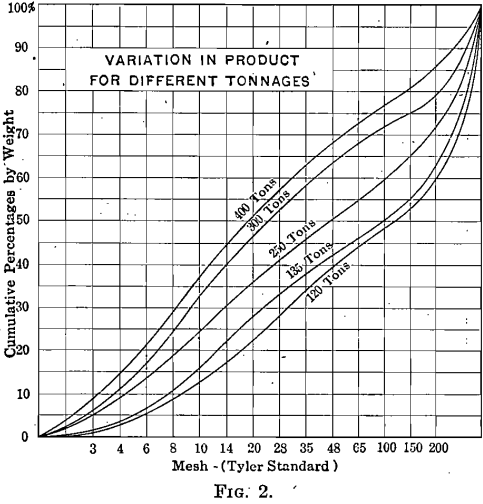
Conditions Determining Fineness of Crushing
There is a general impression that the grate acts as a screen or sizer. This is true to a limited extent, but it is not of primary importance. The fineness of product delivered by a ball mill, the size of feed, ball charge, and speed remaining constant, depends upon the tonnage fed, the density of the pulp (water to solids ratio), size of balls, and, when operating in closed circuit, on the efficiency of the external classifying apparatus. The screen analyses plotted in Fig. 2 show the effect of varying tonnages, other factors remaining constant. They are from actual results with a 6 by 4-ft. mill.
The experience of operators at two western plants verifies the statement that an assorted charge, containing a certain percentage of small balls, is desirable for a fine product.
The screen analyses plotted in Fig. 3. show the difference in product when the initial charge included only 5-in. and 2-in. balls, and when the same charge contained a large percentage of 4, 3, and 2-in. balls. In some respects, these results do not agree with what would be expected, but I will not attempt to propound a theory to explain the deviations at this writing.
The peripheral-discharge mill differs from a trunnion-discharge mill, in the character of its product in that a small amount of moisture will

give a fine product and a large amount a coarse product. As the discharge is entirely at the periphery, and does not depend upon any classifying action to overflow the, finished product, the greater the amount of water added the quicker the pulp will pass through the mill and the coarser the product.
In mills provided with means for raising the discharge or pulp level from the periphery to some intermediate height between the periphery and the trunnion, the fineness and the amount of oversize can be controlled within certain limits. No.figures are available showing these differences, but from practical results in the field it appears that a wide variation can be obtained by this means.
The grate should, of course, retain some oversize, but this action can be carried to extremes, especially when a fine product is desired, as the consequent diminished capacity is not compensated by the reduction of oversize. In all cases when a fine product is desired, it is advisable to run the mill in closed circuit with an efficient external classifier. The principal function of the grate is to retain the ball charge in the mill, while permitting a peripheral discharge. The efficiency of the classifier, when a ball mill is run in closed circuit, directly affects both tonnage and fineness. This will be discussed under capacity.
What Affects Ball Mill Capacity
Capacity of ball mills depends upon the following factors: fineness of grinding, weight or volume of ball charge, hardness of material, size of grate openings, and size of balls, other factors remaining constant. Practically speaking, the most important limiting factors for capacity have
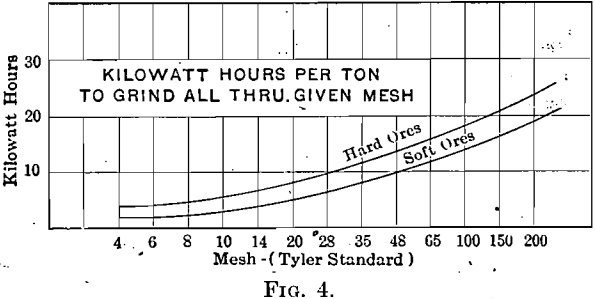
been the size of the feed opening in the trunnion, the type of trunnion liner, and the type of feeder.
As previously shown, tonnage and fineness are interrelated and the capacity of a ball mill should be figured on the following basis when sufficiently reliable figures have been collected. The kw.-hours required to crush a ton of ore from and to a certain mesh should be arrived at from average operating conditions. A ball mill has a certain definite maximum power rating depending upon its ball load. Multiplying the kw.-hours per ton by the tons required to be crushed per hour, the product will represent the power required, and the mill nearest to that power rating should be selected. Fig. 4 is a preliminary power curve based on the recommended maximum ball charge, together with all available data at hand at the present time; however, 60 or more carefully taken power records would be needed for even an approximately correct curve.
Operating a mill at less than its maximum capacity for a given ball charge will result in excessive wear on lining and balls and produce a finer product than necessary. To crush a ton of ore of a certain hardness and size to a given fineness represents a definite amount of work; hence the capacity of a mill depends upon (a) the hardness, and (b) the ratio of reduction, the latter affecting capacity far more than the former.
It is useless to expect a large capacity from a mill operated with balls of a size too small to crush the ore, or when the balls are of a composition that will not withstand the shock of impact and shatter themselves to fragments. Hard ores, when fed direct from a crusher, require a proper percentage of 5-in. steel balls to do effective work. A 4-in. steel ball is often sufficient for some of the softer porphyry ores. Smaller steel balls may be used for regrinding work, but the charge should contain a per-
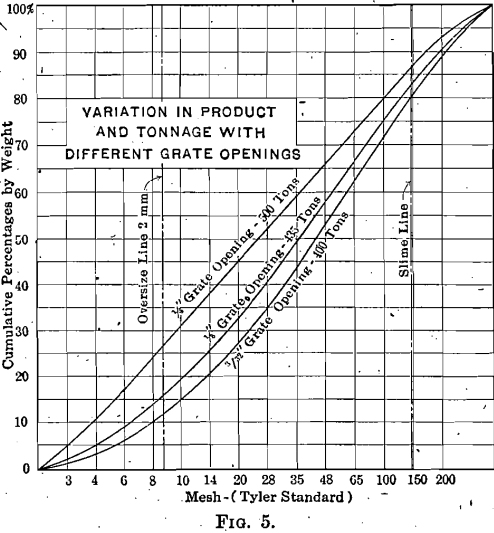
centage of 2-in. steel balls when working on hard ores. For regrinding soft ores, cast iron or composition balls may be used.
Where a fine product is desired together with a minimum amount of oversize, the grate opening should not be diminished. Smaller grate openings will reduce the amount of oversize but the decreased tonnage is not compensated. In such cases it is advisable to depend on an external classifier and operate the mill in closed circuit; the grate bars should be set with at least 1/8-in. opening. Where a coarse product is desired, for example for concentrating table work, the grate may be used as a sizer and an open-circuit scheme adopted.
Fig. 5 shows a typical example of the variation as to both tonnage and product that can be obtained with different grate openings.
When the mill is operated in closed circuit the efficiency of the classifier directly affects the capacity and it is important that the classifier be of proper size and properly operated. In one case observed, a classifier of the mechanical drag type was set with the wrong slope; correcting the slope approximately doubled the capacity of the mill. Classifiers of the mechanical drag type, in order to make an efficient separation, must be operated with proper consistency of pulp in the classifying zone, the slope and length of the sand plane must be correct, and the speed of the drag must be suited to the material.
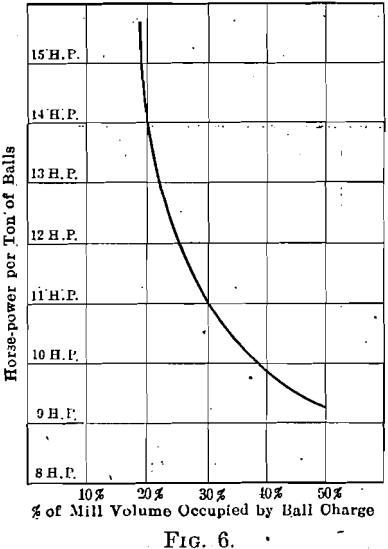
Conditions Affecting Ball Mill Power
Power depends principally upon the weight of ball charge, an approximate figure being 9 to 10 hp. per ton. However, the power per ton of balls will vary according to the percentage of volume the ball charge occupies in the mill. An approximate curve from data at hand is given in Fig. 6, from which it will be seen that the power required per ton of balls is least when the mill is loaded half full and that the curve rises very rapidly as the ball load is reduced. A charge greater than half full causes a balancing effect until, when the mill is full, the power required is practically only that necessary to take care of friction after starting.
When the volume of ball charge is reduced, within certain limits, the power consumption per unit of ball charge is increased, because the center of gravity of the charge is further from the axis of the mill; but as the mass of balls is more active and circulates more freely, the crushing efficiency is increased proportionately to the increase in power consumption per-ton of ball load.
There are a number of ball mill installations for fine crushing in the West. Most of these are arranged in two or more stages where a product finer than 100-mesh is desired, and there seems to be little difference of opinion as to the advantage of such an arrangement. Where coarser products are desired say, through 48-mesh, both single-reduction and stage-crushing installations are found. Stage crushing seems to have higher efficiency, but when first cost and simplicity are considered, the single-reduction installation seems to be more desirable, especially for small plants.
The curves (Fig. 7) plotted from recent tests show the power required per ton of material crushed under-varying capacities. It can be seen that the power rises rapidly at the expense of capacity when a fine product

is desired, and when compared with an average power curve it would make a saving to run a large tonnage through several stages. The phrase “single reduction” as applied to ordinary ball mill practice is misleading, because in the most common application of the ball mill, running in closed circuit for preparing feed for flotation, a great deal of the material is returned from once to six or seven times before it is finally reduced. The most efficient installations in practice are undoubtedly those which have a large return circuit and the mill is crowded, making a small reduction at each pass through the mill, but handling a large tonnage at the same time.
Ball Mill Crushing
The ball mill is not to be recommended for all and sundry problems in the milling field. It is not suitable for concentration work where the ore contains a large amount of coarse mineral easily pulverized. Where crushing to 12-mesh and finer is necessary to release the mineral, the ball mill makes a suitable product when properly operated, and is as good as any other regrinding machine. The installation of concentrating
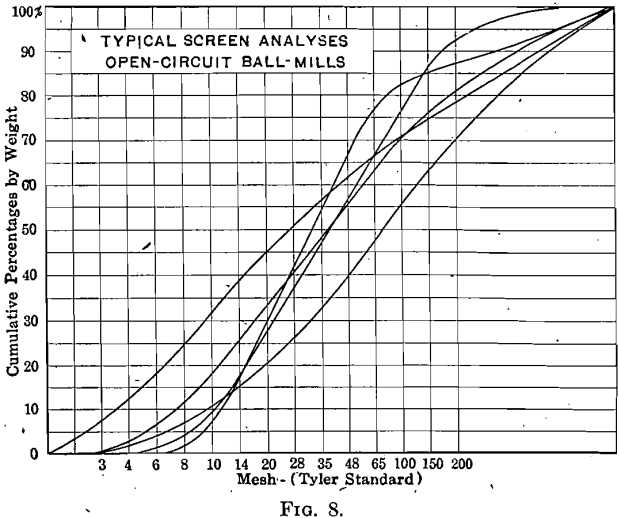
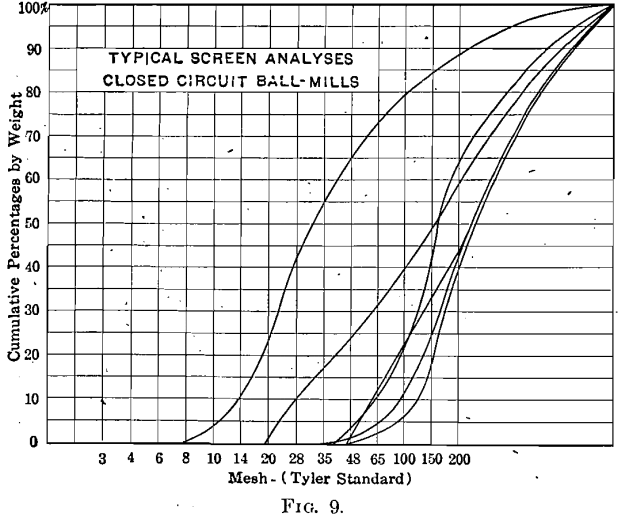
tables within the mill circuit, as practised at Stoddard, Ariz., is a notable advance in this class of work. The special field of the ball mill, however, is for products 20-mesh and finer.
The use of ball mills for reducing crusher product to 85 per cent,: below 200-mesh in two stages, as practised at the United Eastern, Tom Reed, and Montana mines, in Arizona, is a distinct advance in fine crushing. The simplicity, small floor space and large capacity of these installations are especially notable.
While there is not such economy in power nor so small a number of repairs as compared with a stamp- battery and tube-mill plant of the same capacity, the operating troubles and attendance are much reduced.
The curves in Figs. 8 and 9 show typical screen analyses of ball mill products, to give a better indication of the class of work that may be expected.
How to Feed a Ball Mill
The most desirable method of feeding coarse material is the arrangement as installed at the Tom Reed mill. The crusher product is fed direct from a bin to an apron feeder, the speed of which is controlled by a Reeves variable-speed transmission device, having a small hand crank, sprocket, and chain conveniently situated for the mill operator. This insures absolute control and allows quick changes.
When a ball mill having a proper crushing load is rotated at the critical speed, the balls strike at a point on the periphery about 45° below horizontal, or S in Fig. 1. An experienced operator is able to judge by the sound whether a mill is crushing at maximum efficiency, or is being over- or under-fed. Excessive rattling denotes under-feeding; a sound of impact at W (Fig. 1) indicates overloading; while under proper conditions, the impact will be heard near S.
When a ball mill fitted with a diaphragm is over-fed, the mill fills up to a certain level, then stops, crushing and discharges any additional feed back through the feed trunnion. Once over-fed, it takes from 30 min. to 2 hr. to free itself. Ball mills, therefore, should be provided with a central opening in the diaphragm connecting with the discharge trunnion, to prevent over-feeding and the delays incidental thereto.
The greatest difficulty in feeding most ball mills, when running on large tonnages and coarse feed, say, ½ to 3 in., is due to the restricted area of the feed trunnion, which limits the quantity of coarse material that can be fed through it. A few simple calculations will show the velocity necessary to pass a given quantity feed through the trunnion. It can also be shown mathematically that the average spiral in the trunnion liner does not advance the feed rapidly enough; therefore, instead of aiding, it retards the feeding. These results are confirmed in practice. A smooth liner, tapering from the feeder into the mill, does not retard the flow of the feed, and is, therefore, more efficient than the spiral. Experiments with small models, as well as experiments in the field, corroborate these conclusions. A short trunnion with large diameter is essential for feeding a large tonnage to a ball mill.
The engineering department of the Allis-Chalmers Manufacturing Co. has recently conducted some experiments with feeders modeled after the various types in use, on a scale of 1 in. per foot. The feeders were operated at constant speed conformable with present practice, the material delivered in a given time being weighed. The following con-

clusions were drawn: ” The intake of a single-scoop feeder has far greater capacity than the throat or trunnion of the mill, and there is no good reason for using a double- or triple-scoop feeder, the capacity of the feeder not being controlled by the quantity it will pick up, but by the quantity that it can discharge through the throat or trunnion.” These experiments further demonstrated that the capacity of a spiral feeder is in direct proportion to the length of the path of the spiral. In other words, a spiral feeder embodies all the principles of the Frenier sand pump, in which the long path of the spiral increases the pressure which forces the feed into the trunnion opening.
Fig. 10 shows a double-scoop feeder without a partition; Fig. 11 shows the same feeder with the two spirals connected across the center of the trunnion opening, making a partition so that the material taken up cannot drop from one scoop into the other. Fig. 12 shows a single-spiral feeder; Fig. 13 shows a triple-spiral feeder; and Fig. 14 shows a standard combination feeder which has a single spiral.
Disregarding the influence of the trunnion liner as determining the relative capacity of feeders, the experiments demonstrated that No. 12, the single-spiral feeder, has the greatest capacity; No. 11, double-spiral feeder with the partition across the trunnion opening, gave the next best capacity, which, however, was less than 50 per cent., that of No. 12. The capacity of No. 10 was only about 25 per cent, that of No. 12. The capacity of the triple-scoop feeder, Fig. 13, was but very little greater than that of No. 11. The results clearly demonstrate that increasing the number of spirals of scoops does not add to the capacity of a feeder.
Consistency of Pulp in Ball Mill
The ratio of moisture to solids is important in ball mill work. From actual operation it has been observed that fine grinding is best done when water constitutes 33 to 40 per cent, of the pulp, or the water-to- solids ratio is 1 : 2 or 1 : 1½. Where a minimum of fine material is desired, 50 per cent, and upward of water is desirable.
Grinding Ball Consumption
Ball consumption varies with the fineness of the product, hardness of the ore, quality of ball, and whether a mill is run in closed or open circuit. The ball, consumption for mills delivering a coarse product, all passing 8-mesh- and containing 10 to 20 per cent. below 200-mesh, the mill being run in open circuit, is about ½ lb. per ton for steel balls and 1 lb. for cast composition balls.
The average ball consumption for mills in closed circuit has been plotted in Fig. 15 for steel balls and for cast composition balls. Enough data are not available to plot curves for hard and soft ores, and individual figures will vary considerably from the average of the curves, which are given merely a guide as to what may be expected and also to show the increased consumption with finer grinding. It should be noted that the curves apply to products practically all of which are finer than the meshes indicated, up to 65-mesh. Points on the curves representing finer products are for mills generally regrinding 10- to 20-mesh feed; hence corresponding amounts must be added to give the total ball consumption for reducing from crusher size to 100-mesh and finer.
Ball Mill Liner Consumption
Average consumption of shell liners, for both chrome and manganese steel, is 1/3-lb. per ton of ore crushed. The consumption of lining seems to be fairly constant regardless of the hardness of the ore, fineness of product, or other conditions. The greatest wear on the lining is probably caused by the impact of the balls and by their slippage on the shell during the period of acceleration. If the mill is running below capacity the wear will increase.
There are numerous types of liners on the market, and improvements are constantly being made, but the greatest improvement made recently
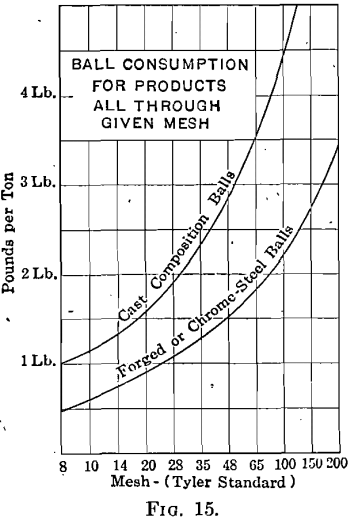
is the general increase in weight and thickness. The proportion of scrap has been very high, and the consumption stated above may be reasonably expected to be diminished with heavier and thicker liners. Regarding the shape of liner, there is considerable difference of opinion. The smooth liner is probably as efficient as any of the others if run at slightly higher speed.
Hard-iron liners have not been found satisfactory when used with balls of 5 and 4-in. diameter, as, they have invariably failed by cracking and breaking, but with balls of 2-in. diameter and smaller they are sufficiently durable. It is possible that a heavy hard-iron liner backed and set in cement mortar might be successful, but this has not yet been tried as far as we know.
The loosening of liners may be avoided by using deeply countersunk bolts of large diameter with double nuts. When the liners are first put in place, after running the mill for several hours the bolts should be gone over again and the nuts tightened with a short wrench and hammer. Later, after the feed is on, they should be gone over once more. Leakage around bolt holes is caused entirely by loosening of the bolts due to lack of tightening or a worn-out lining. If candlewicking is used as packing around a bolt; between the shell and the washer, and the nut is kept tight, no leakage will occur until the liners are worn out.
